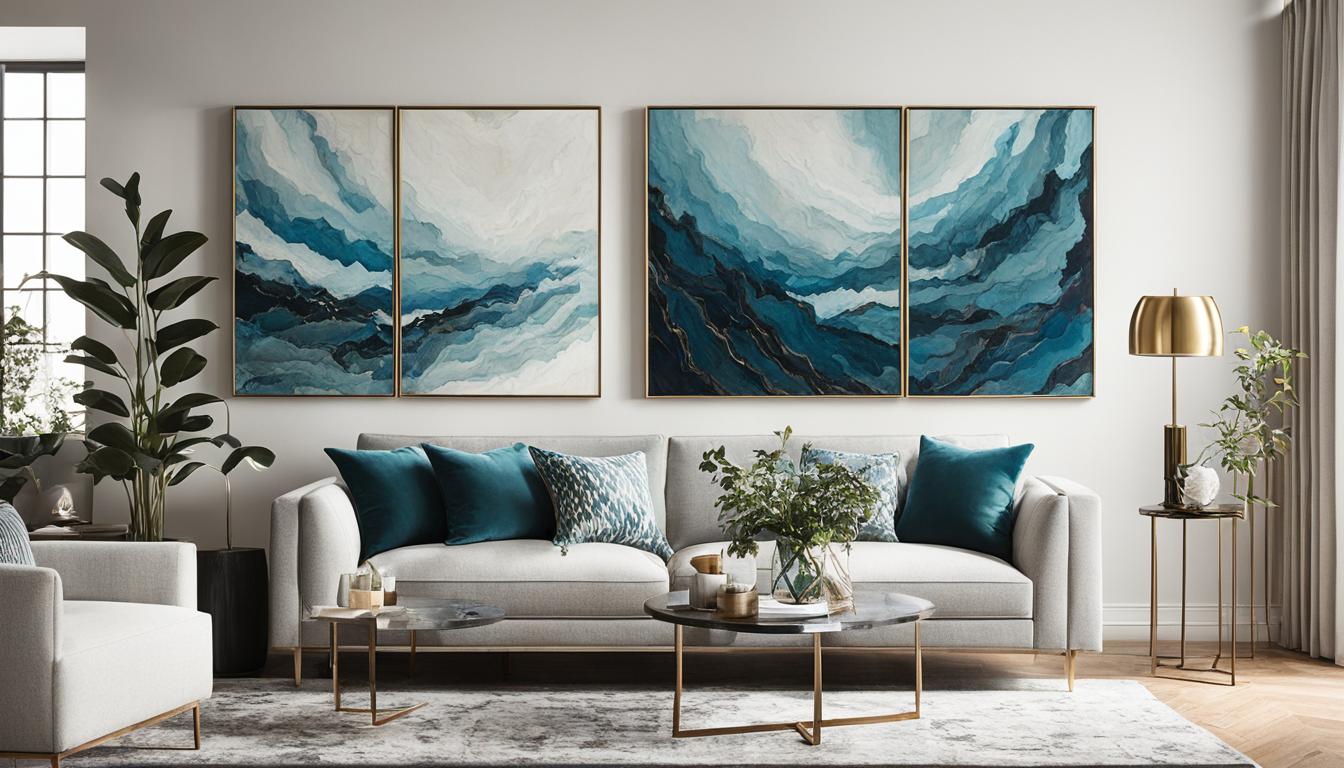 Art has a transformative power in the world of interior design. It adds a touch of elegance, personality, and sophistication to any space. Incorporating artwork into your home decor can breathe new life into your living environment and create a unique atmosphere that reflects your individuality and style. From choosing the right art pieces to establishing a color scheme and incorporating artistic elements, there are numerous ways to integrate artwork seamlessly into your interior design. In this article, we will explore the intersection of art and home decor, providing you with practical tips and inspiring ideas to make your space a true work of art.
Art has a transformative power in the world of interior design. It adds a touch of elegance, personality, and sophistication to any space. Incorporating artwork into your home decor can breathe new life into your living environment and create a unique atmosphere that reflects your individuality and style. From choosing the right art pieces to establishing a color scheme and incorporating artistic elements, there are numerous ways to integrate artwork seamlessly into your interior design. In this article, we will explore the intersection of art and home decor, providing you with practical tips and inspiring ideas to make your space a true work of art.
Key Takeaways:
- Artwork plays a vital role in interior design, adding depth and character to your space.
- Choose art that speaks to you and aligns with the overall style and mood you want to achieve.
- Analyze the artwork to understand the artist’s vision and use it as a guide in your design choices.
- Establish a harmonious color scheme based on the dominant colors in your chosen artwork.
- Incorporate artistic elements from the artwork, such as patterns, textures, and shapes, into your decor.
Step 1: Choose Your Artistic Inspiration
When embarking on an art-inspired interior design project, the first and most crucial step is to choose your artistic inspiration. This initial decision sets the tone for your entire endeavor, influencing the atmosphere and personality of your space. The art piece you select becomes the focal point that breathes life into your home decor, infusing it with a specific style, mood, or narrative.
Art comes in various forms, each with its unique charm and visual impact. Consider exploring options such as paintings, sculptures, photography, and textiles. With a plethora of styles and choices available, you have the freedom to express your personal taste and aesthetic preferences.
“Art enables us to find ourselves and lose ourselves at the same time.” – Thomas Merton
When choosing your artwork, take a moment to reflect on the emotions and impressions you want to evoke in your space. Are you drawn to vibrant and bold colors or serene and muted tones? Do you envision a modern and abstract piece or a traditional and timeless masterpiece? Consider how the artwork aligns with your overall design vision and seamlessly integrates into your existing decor.
Exploring Art Styles
Understanding different art styles can also guide your selection process. From classical and Renaissance art to abstract expressionism and contemporary minimalism, each style carries its own artistic vocabulary and historical significance. Researching various art movements can help you explore the breadth of artistic possibilities and identify the styles that resonate with you.
| Art Style | Description |
|---|---|
| Impressionism | A style characterized by capturing fleeting moments and light effects, focusing on loose brushwork and vibrant colors. |
| Minimalism | A style known for its simplicity, featuring clean lines, geometric shapes, and a limited color palette. |
| Surrealism | An avant-garde style that explores the realm of dreams and the unconscious, often featuring juxtapositions and unexpected visual elements. |
By understanding art styles, you can identify the ones that resonate with your personal taste and align with your desired interior design aesthetic.
Remember, the artwork you choose will serve as the heart and soul of your art-inspired home decor. It is a reflection of your unique personality and creative expression. So take your time, explore different art forms, and select the piece that speaks to you. Let the chosen artwork guide you throughout the rest of your interior design journey.
Step 2: Analyze the Artwork
Careful art analysis is crucial when incorporating artwork into your interior design project. By understanding the artwork on a deeper level, you can effectively translate the artist’s vision into your space. Here are key steps to help you gain insights into the artwork:
- Consider the Emotional Power of Colors
Dive into the colors used in the artwork. Analyze how they interact with one another and the emotions they evoke. Colors have the ability to influence the atmosphere of a room, and by understanding their impact, you can create a harmonious environment in your space.
- Explore the Artwork’s Mood
Every artwork carries a distinct mood, whether it’s serene, vibrant, or melancholic. Take note of the emotions the artwork elicits and consider how you can incorporate this mood into your interior design. Matching the mood of the artwork with the desired ambiance of your space will help create a cohesive and engaging environment.
- Decipher the Artist’s Intention
Interpret the artist’s vision and intention behind the artwork. Consider the story or message the artist is trying to convey, and how this aligns with your own design goals. Understanding the artist’s perspective will guide your choices in decor, furniture, and overall design aesthetic.
By decoding the artist’s vision through art analysis, you unravel the rich layers of the artwork and gain valuable insights that will shape your interior design project.
As you delve deeper into the artwork, a clearer understanding of its essence will emerge. Take the time to reflect on the colors, mood, and artist’s intention, allowing them to guide your design decisions and create a space that truly captures the spirit of the artwork.

Continue to step 3, Establish a Color Scheme, to learn how to translate the analyzed artwork into a cohesive palette for your interior design project.
Step 3: Establish a Harmonious Color Scheme
Crafting a captivating color scheme is essential to create an art-inspired interior that harmonizes with your chosen artwork. By identifying the dominant colors in the original piece, you can build a cohesive color palette that brings your design to life.
Start by analyzing the artwork and noting down the colors that stand out the most. Be attentive to the emotional impact of these colors, as they will shape the overall mood of the room. Choose one dominant hue from the artwork and use it as the foundation color for your walls.
Once you have your foundation color, select complementary shades from the artwork to incorporate into furnishings, decor, and accent pieces. These secondary colors will enhance the visual connection between the artwork and the space, ensuring a seamless and harmonious design.
Tip: Consider using an online color palette generator to explore different combinations and to ensure a balanced and visually appealing result.
Applying Color Psychology to Create an Emotional Impact
Colors have the power to evoke specific emotions and establish a desired ambiance in a space. Understanding the emotional impact of different colors can further enhance the overall experience of your art-inspired interior design.
| Color | Emotional Impact |
|---|---|
| Warm tones (e.g., red, orange, yellow) | Energetic, inviting, and uplifting. They can stimulate conversation and create a cozy atmosphere. |
| Cool tones (e.g., blue, green, purple) | Calming, soothing, and serene. They can promote relaxation and contemplation. |
| Neutral tones (e.g., white, gray, beige) | Versatile, timeless, and understated. They can provide a neutral backdrop that allows the artwork to shine. |
By carefully choosing the colors for your art-inspired interior, you can create a space that not only complements the artwork but also elicits the desired emotions and captures the essence of your artistic inspiration.
Step 4: Incorporate Artistic Elements
Now that you have chosen your artwork and established a color scheme, it’s time to infuse your space with artistic elements that bring your design to life. By analyzing the patterns, textures, and shapes present in your chosen artwork, you can create a cohesive and visually captivating interior.
Patterns play a crucial role in adding visual interest and depth to a room. Take inspiration from the patterns in your artwork and incorporate them into textiles such as curtains, rugs, or upholstery. These elements will not only draw attention but also create a harmonious connection between the artwork and the rest of the space.
Textures offer another layer of visual and tactile appeal. Look closely at the textures in your artwork and find ways to introduce them into your design. Consider using materials like wood, stone, or textured wallpapers to bring these elements to life. The contrasting textures will enhance the overall sensory experience of the room.
Shapes are yet another artistic element that can be integrated into your interior design. Analyze the shapes and forms present in your artwork and reflect them in the furniture silhouettes or architectural details. Whether it’s the curves of a sculpture or the angular lines of a painting, incorporating these shapes will create a harmonious flow and visual connection throughout the space.
FAQ
How do I choose the right art for my home decor?
When selecting art for your home, consider the style, mood, and narrative you want to convey. Choose art forms such as paintings, sculptures, photography, or textiles that align with your aesthetic preferences.
What should I consider when analyzing artwork for interior design?
When analyzing artwork, pay attention to colors, mood, and the artist’s intention. Understanding these aspects will help guide your interior design choices and create a cohesive space.
How can I establish a color scheme based on my chosen artwork?
Identify the dominant colors in your chosen artwork and use them as the foundation for your color palette. Apply the main hue to the walls and incorporate the other colors through furnishings and decor to create harmony.
How can I incorporate artistic elements from the chosen artwork into my interior design?
To incorporate artistic elements, draw inspiration from the artwork’s patterns, textures, and shapes. Utilize these elements in textiles, materials, furniture, and architectural details to create a visually captivating space.
